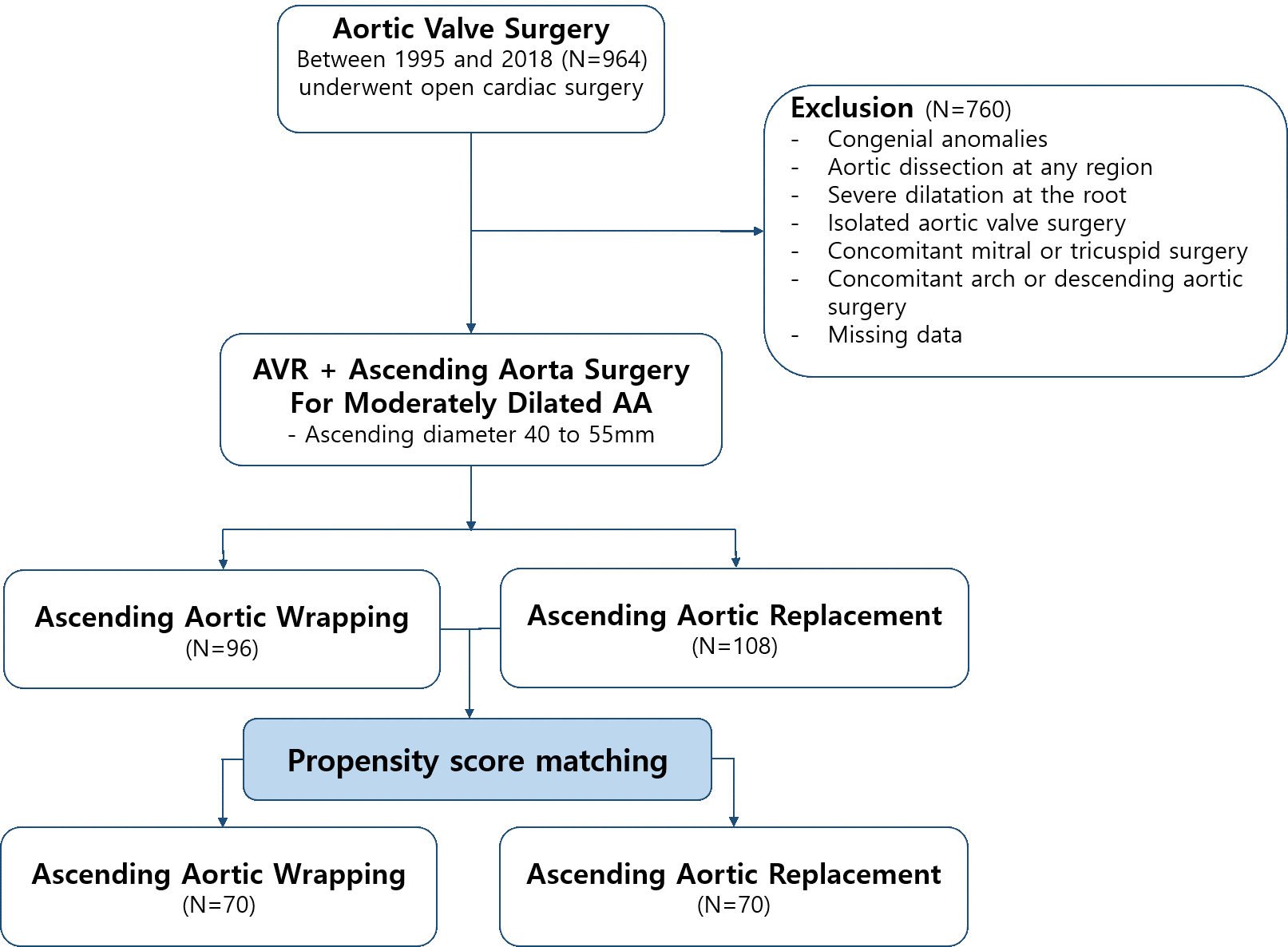초록접수 현황
| 20F-068 | 구연 발표 |
The Long-term fate of ascending aorta aneurysm after wrapping versus replacement
Hyo-Hyun Kim, Sak Lee, Seung Hyun Lee, Jung-Hwan Kim, Young-Nam Youn, Kyung-Jong Yoo, Hyun-Chel Joo
Division of Cardiovascular Surgery, Severance Cardiovascular Hospital, Yonsei University College of Medicine, Korea
Purpose : To examine the long-term fate of aortic diameter expansion at four cardiac regions (annulus, sinus, ascending aorta and proximal arch) after wrapping or replacement during aortic valve surgery of the moderately dilated ascending aorta.
Methods : From January 1995 to December 2018, 964 consecutive patients who underwent aortic valve replacement at our institution were reviewed. Of them, 204 (mean age 60.7±7.4 years) underwent ascending aorta wrapping (n=96) or replacement (n=108) for moderately dilated ascending aorta (40 to 55 mm). The overall fate of the aortic diameter was analyzed with a linear mixed-effect model. The median follow-up duration was 7.1 years.
Results : After propensity score matching, the baseline maximal ascending aortic diameter median value was 47.3±3.1 mm and 49.4±13.5mm in the wrapping and replacement groups, respectively. The annulus, sinus or ascending aorta did not re-dilate in either group. The proximal aortic arch diameter significantly increased over time (0.343 mm/year; p=0.006) in the wrapping, but not in the replacement group (0.066 mm/year; p=0.649). Multivariable competing risk analysis identified the initial ascending aorta diameter at the wrapping procedure as an independent risk factor of proximal arch re-dilation (0.071±0.037, p<0.001). The cutoff value was an initial ascending aorta diameter of 47.2 mm for the prediction proximal arch re-dilation (area under curve 0.703, p=0.014).
Conclusion : Aortic wrapping and replacement may be long-term durable treatment options in patients with a moderately enlarged ascending aorta. We suggest careful evaluation of re-dilation in the proximal arch after an aorta wrapping procedure.
Methods : From January 1995 to December 2018, 964 consecutive patients who underwent aortic valve replacement at our institution were reviewed. Of them, 204 (mean age 60.7±7.4 years) underwent ascending aorta wrapping (n=96) or replacement (n=108) for moderately dilated ascending aorta (40 to 55 mm). The overall fate of the aortic diameter was analyzed with a linear mixed-effect model. The median follow-up duration was 7.1 years.
Results : After propensity score matching, the baseline maximal ascending aortic diameter median value was 47.3±3.1 mm and 49.4±13.5mm in the wrapping and replacement groups, respectively. The annulus, sinus or ascending aorta did not re-dilate in either group. The proximal aortic arch diameter significantly increased over time (0.343 mm/year; p=0.006) in the wrapping, but not in the replacement group (0.066 mm/year; p=0.649). Multivariable competing risk analysis identified the initial ascending aorta diameter at the wrapping procedure as an independent risk factor of proximal arch re-dilation (0.071±0.037, p<0.001). The cutoff value was an initial ascending aorta diameter of 47.2 mm for the prediction proximal arch re-dilation (area under curve 0.703, p=0.014).
Conclusion : Aortic wrapping and replacement may be long-term durable treatment options in patients with a moderately enlarged ascending aorta. We suggest careful evaluation of re-dilation in the proximal arch after an aorta wrapping procedure.

책임저자: Hyun-Chel Joo
Division of Cardiovascular Surgery, Severance Cardiovascular Hospital, Yonsei University College of Medicine, Korea
발표자: Hyo-Hyun Kim, E-mail : ysgs@yuhs.ac


